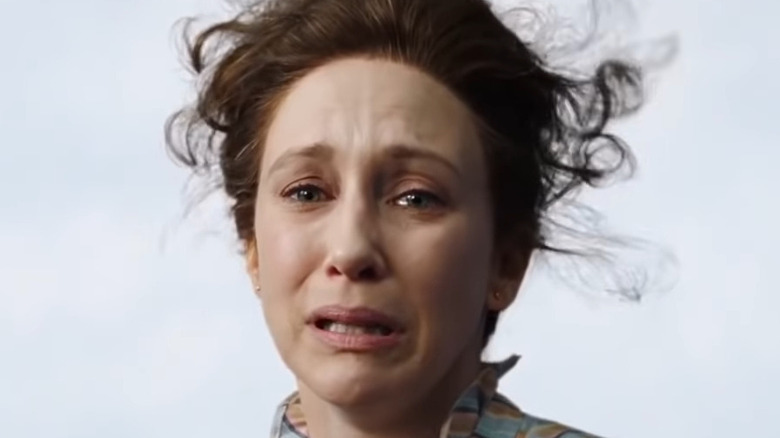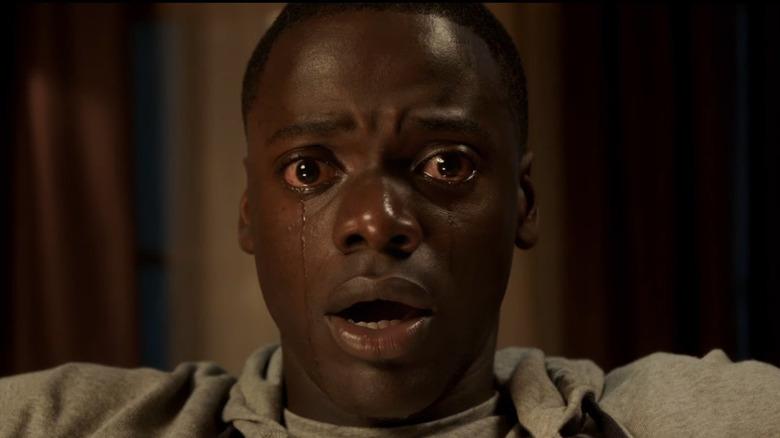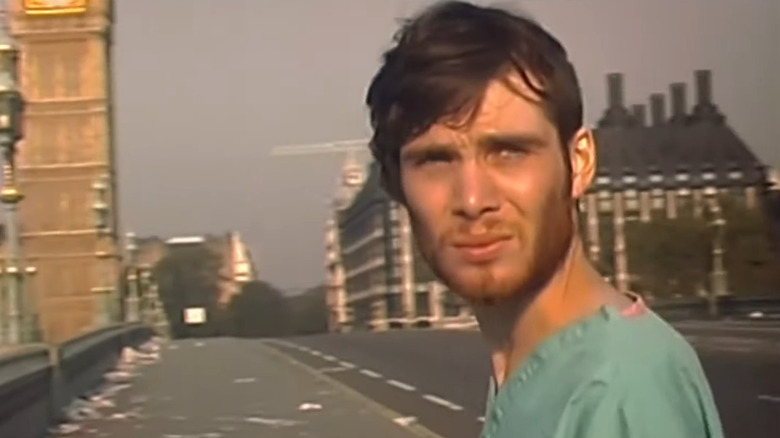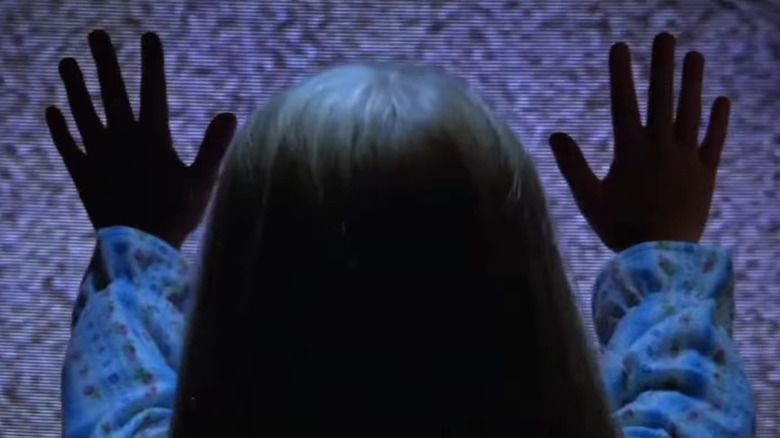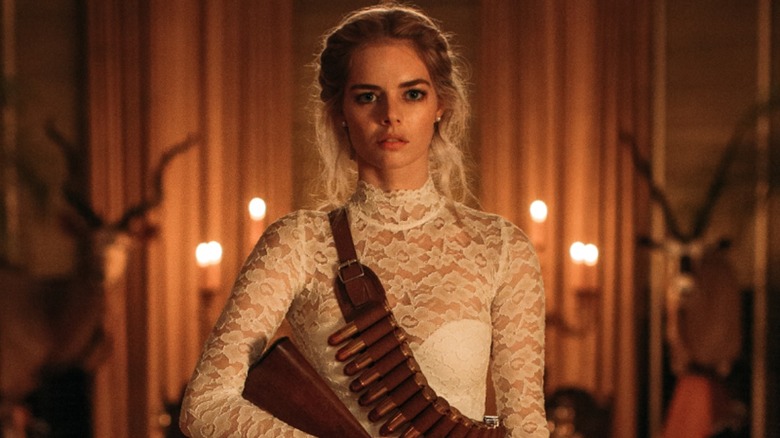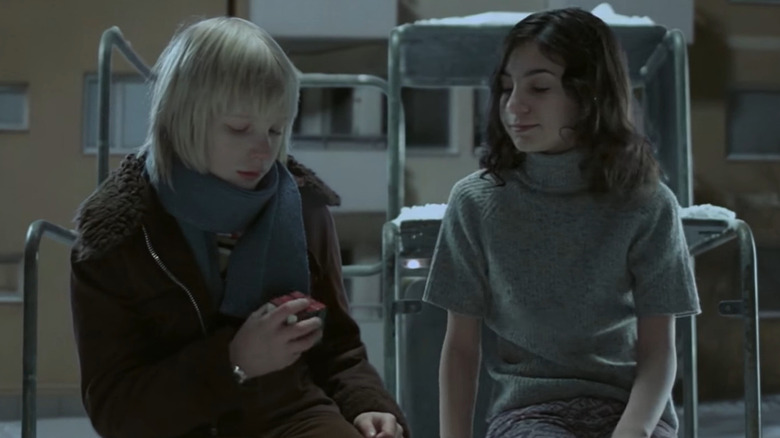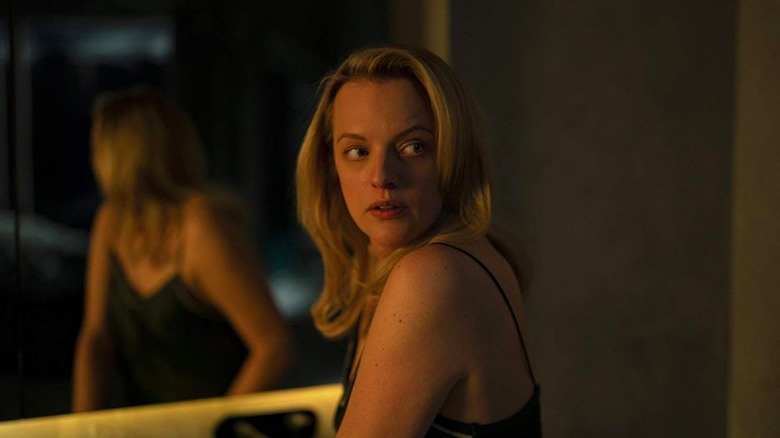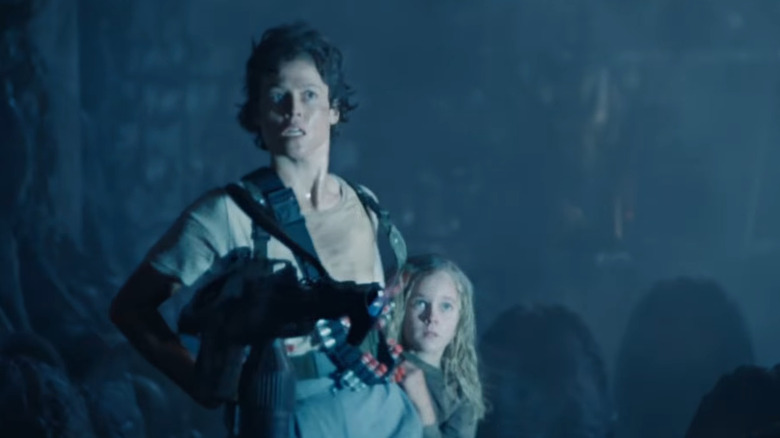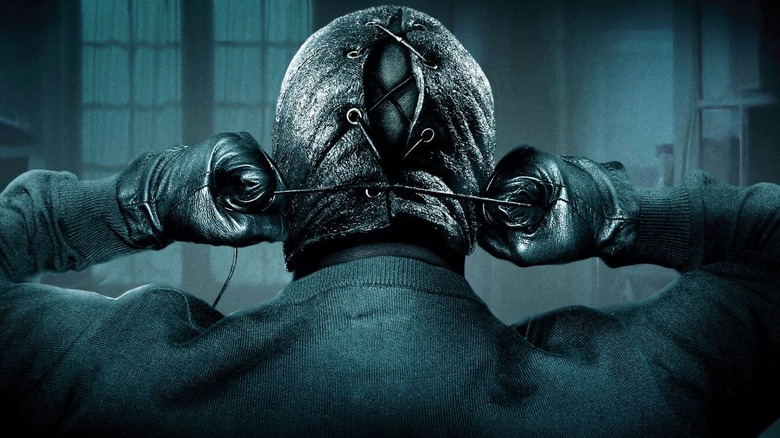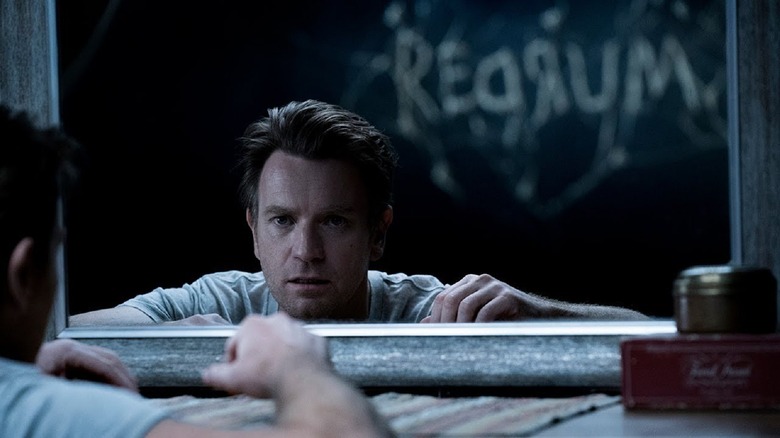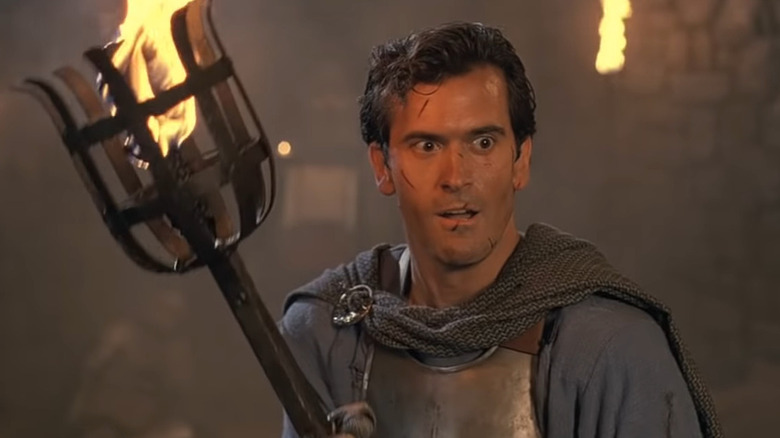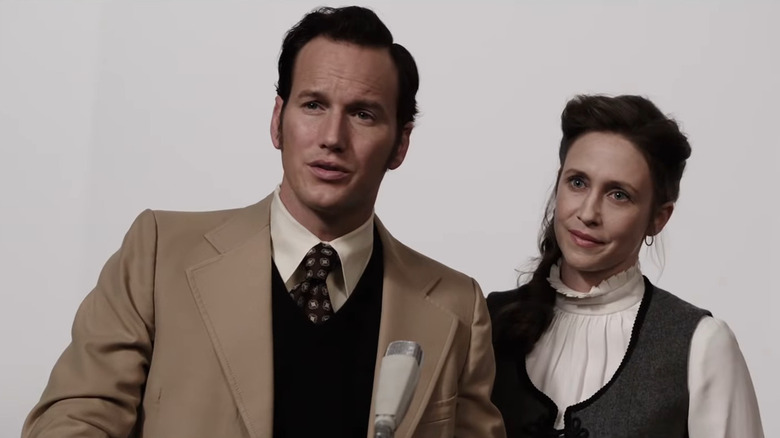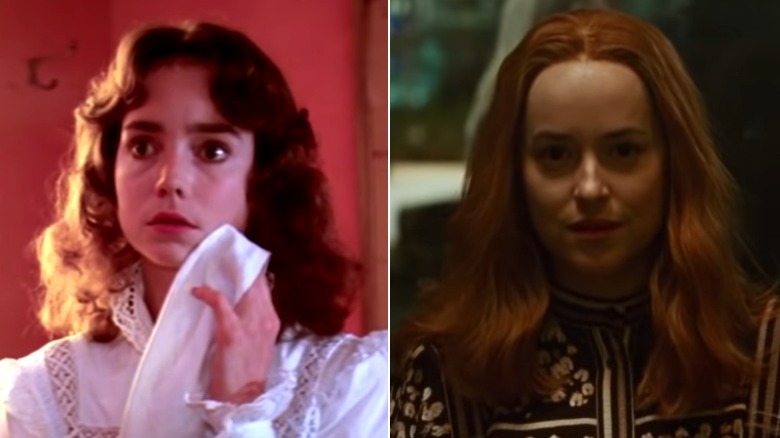Disturbing Movies With Stunningly Happy Endings
Movies can set out to provide their audiences with many different feelings. Some seek to make them laugh. Others look to make them cry. And others still want to make their skin crawl. The sensations of dread and fear so inherent to the horror genre are not the kind you'd think viewers would go out of their way to experience. But as with roller coasters and bungee jumping, sometimes the thrill of being terrified is too exhilarating to resist.
This is why it can sometimes be jarring when a film that had previously reveled in exploring the darker, more sinister side of cinema will suddenly pivot in its final moments to a much more optimistic register. Even if the rapid gear shift to positivity is justified by the trajectory of the story being told, it can still feel unexpected to be blinded by the light after spending so much of the runtime in the darkness. Here are over a dozen films that were largely haunting, only to conclude in a way that seems downright uplifting.
It may seem obvious from the title of this list, but in the interest of full disclosure, there will be major spoilers for all films discussed here.
Get Out
Before 2017's "Get Out," Jordan Peele was known for his sublime comedy chops in "Key & Peele," so when he decided to helm a horror film, it was a bit of a surprise. His resulting film was a massive success by every metric, though. Beloved by audiences and critics alike, it earned over $255 million worldwide, and Peele scored the Oscar for Best Original Screenplay.
The story follows Chris (Daniel Kaluuya), a Black man who visits the family of his white girlfriend Rose (Allison Williams). Things go from mildly uncomfortable to deeply unsettling when he discovers that they run a secret operation that transfers the brains of aging white people into young, fit bodies, and Chris has been seduced by Rose to become their next victim. After a terrifying visit to the "sunken place," Chris fights back and dispatches his girlfriend and her family in a spectacularly bloody fashion. However, another moment of tension arises when, during Chris' bloody escape, he sees flashing lights ahead.
Those well-versed in horror history (not to mention centuries of racial injustice) might reasonably expect a tragic ending where our hero is arrested or gunned down (as in an alternate ending later revealed by Peele). Fortunately, the vehicle is driven by Chris' friend Rod (Lil Rel Howery). The two drive off into the night, leaving the scene of his grisly slaughter behind. The film even ends with a moment of levity, with Rod reminding Chris that he told him not to go in the first place.
28 Days Later
Danny Boyle's grungy thriller "28 Days Later" was an instant genre classic upon release in 2002. In the film, activists free chimpanzees from a lab and inadvertently release a virus that infects people with rage, and depending on who you ask, turns them into a form of zombie — albeit one that sprints after its prey rather than slowly shuffling like others of its cinematic ilk.
Weeks after the outbreak, Jim (Cillian Murphy) wakes up from a coma into a world he no longer recognizes. Before long, he teams up with some fellow survivors as they attempt to reach a safe haven promised by radio broadcasts. Things go from bad to worse, however, when it turns out that the military regiment sending the messages is trying to lure female survivors in with a misguided plan to repopulate the world.
Jim rescues his new friends from the twisted soldiers by unleashing an infected man upon them, and the result is a blood-soaked finale in which Jim is shot. Even though they escape, surely nothing but horror awaits them in a world where mankind's savage nature has run this rampant, right? Not so, as the last moments of the film show the characters recovering in a pleasant cottage and suggest that they may be saved by a passing fighter jet. Though we know that things eventually go badly again in the sequel "28 Weeks Later," the survivors of this film seem like they've gotten past the worst of it.
Poltergeist
A collaboration between producer Steven Spielberg (who at the time was also directing the family-friendly "E.T. the Extra-Terrestrial") and director Tobe Hooper (most famous for "The Texas Chain Saw Massacre") was always going to have the potential to be tonally jarring. Yet for most of its runtime, the 1982 ghost story "Poltergeist" maintains a significantly scary atmosphere. It follows a suburban family that gradually discover their new community has been built on top of a former cemetery.
The disturbances start in seemingly benign ways, such as chairs stacking on their own. But before long, the tree in the backyard is grabbing the kids, as is a terrifying clown doll one of them inexplicably keeps by his bed. By the time the youngest daughter Carol Anne is abducted by the spirits she speaks to through the TV, any number of unnatural occurrences seem possible.
This all leads to the revelation of a dark creature referred to as the "Beast," which comes after the family while the Freeling family patriarch Steven (Craig T. Nelson) is away. The poor mom Diane (JoBeth Williams) is nearly drowned by a pool of skeletal corpses, and the family just barely manages to get away before the house collapses into a portal. One might think that such an ordeal would be seriously traumatic for those involved, yet the final scene shows the family relaxing at a motel, grateful to be alive and together. It even ends with a gag that shows the father unplugging and removing their room's TV, just to ensure no spirits can interrupt their newfound safety.
Ready or Not
Directed by Matt Bettinelli-Olpin and Tyler Gillett of the filmmaking collective Radio Silence (who went on to find even greater success with their reboot of the "Scream" franchise), the 2019 thriller "Ready or Not" stars Samara Weaving as Grace, a newlywed who's marrying into the wealthy Le Domas family. After the wedding, her new in-laws reveal that she must participate in their long-standing tradition of playing a game in order to officially join their ranks.
Unfortunately for all involved, Grace draws the card for Hide-and-Seek. It turns out the Le Domases got their fortune through an ancient pact, and when a new family member draws this card, the rest of the clan must arm themselves and hunt her down in order to provide a blood sacrifice. This leads to a desperate quest for survival as Grace looks for a way to flee their mansion while evading her murderous in-laws. As dawn approaches and the family gets more frantic, she finds increasingly violent ways to turn the tables on them.
Near the end of the film, Grace is captured and the remaining family members rush to finish the blood ritual before the sun rises. However, she manages to escape their clutches just in time for the ritual to fail. Apparently, this leads all members of the family to spontaneously explode in a manner that's both horrific and comedic at the same. Grace then sits back and relaxes as the mansion burns behind her, having dodged a bullet by not becoming part of such a deranged legacy.
Let the Right One In
Based on the novel by John Ajvide Lindqvist, the Swedish film "Let the Right One In" tracks the relationship between Oskar, a 12-year-old loner who's being relentlessly bullied, and Eli, the strange girl who moves into his apartment building. Over time, they build a cute friendship that seems like it could blossom into something resembling young love. There's only one wrinkle: Eli is a vampire, and has been trapped in a young body for years, making her dependent on an older guardian to hunt down potential victims and collect blood for her.
Though the story has a sweet emotional center when it concerns the bond between its young leads, there is still a deeply disturbing undercurrent to the proceedings. Eli's guardian is captured and arrested while attempting to procure blood for her, and ends up pouring acid on his face and jumping from a hospital window to avoid compromising her safety. This leads Eli to have to hunt for her own food, which leads to retaliation from members of the local community.
Even outside of the supernatural elements, there's also the problem of Oskar's desire to kill the kids who frequently torment him. When he does finally strike back, they respond by attempting to drown him in a swimming pool. Fortunately, Eli comes to his rescue and gruesomely dispatches them all. Despite this incredibly bloody climax, the film still has time for an optimistic final scene featuring the two on a train, running away towards their own personal "happily ever after."
The Invisible Man
2020's "The Invisible Man," a loose adaptation of the H.G. Wells novel from "Saw" and "Insidious" co-creator Leigh Whannell, jettisons virtually everything about the original story outside of the core premise that a man can become invisible. Rather than portraying the events from his perspective, the film instead centers on his main victim, ex-girlfriend Cecilia (played by Elizabeth Moss), who had been trapped in an abusive and toxic relationship before escaping.
Though she is informed that her former boyfriend died after she left him, Cecilia doesn't believe that he's really gone. Sure enough, she is soon tormented by an unseen figure who attacks her when no one is looking and then disappears, making her seem increasingly unstable. The titular "Invisible Man" even goes as far as killing Cecilia's sister and framing her for it, which lands her in a psychiatric hospital.
The kill count for this film may be low, but the psychological torture its protagonist endures more than makes up for it. Even after her ex's brother is unmasked wearing the optical bodysuit that grants invisibility, she still feels trapped by the violent relationship. Just when it seems like she might give in due to their unborn child, she suddenly takes fate (and the invisibility suit) into her own hands, killing her abuser once and for all. She even gets to walk off into the proverbial sunset, after her detective friend seemingly lets her off the hook after realizing what she's done. Not a bad outcome considering all she had to go through.
Aliens
Ridley Scott's original "Alien" is a classic of both the science-fiction and horror genres, boasting innovative special effects, an atmosphere of tension and claustrophobia, and a career-defining performance from Sigourney Weaver. Naturally, any potential sequel was going to have its work cut out for it. Fortunately for filmgoers everyone, director James Cameron managed to expand the scale while maintaining the intimate terror of what came before in "Aliens." The result is a sci-fi/action masterpiece as beloved as its predecessor.
Set 57 years after her initial encounter with a Xenomorph, the film finds Ellen Ripley awakened from hypersleep just in time to assist a military expedition to the now-colonized LV-426, where the deadly species were first discovered. Despite travelling with a crew of hardened marines, it doesn't take long for the creatures to begin dispatching them one by one. Their advanced weaponry fails to protect them for long, and soon only a handful are left alive.
In a last-ditch attempt to rescue young Newt, the colony's only living survivor, Ripley goes head-to-head with the Xenomorph Queen, who is none too thrilled to have her babies set on fire. Their grudge match eventually results in the queen being blown out of their ship's air lock, and suddenly all seems right with the world. The planet has been destroyed, the aliens are all dead, and Ripley even has a new surrogate daughter for her troubles. The final moments of the film seem almost hopeful for the future. That is, as long as you ignore the rest of the franchise.
The Collection
"The Collection," a 2012 sequel to 2009's "The Collector," comes from Patrick Melton and Marcus Dunstan, who wrote the "Feast" trilogy and four of the "Saw" films. No surprise that the first film is a grisly, stomach-churning affair involving elaborate booby traps and insidious torture methods. It follows a mysterious figure who kidnaps his victims for nefarious purposes. The film ends with him abducting a man named Arkin, who is inadvertently released at the beginning of the sequel.
This time around, we get a look at the maniac's hideout, an intricate warehouse filled with all manner of spikes and saws. Arkin leads a team of mercenaries in the hopes of retrieving a girl named Elena, and before long, the majority of them get torn apart in increasingly gruesome ways. This is to say nothing of the collection itself, a room filled with abstract sculptures constructed of preserved human body parts.
In the end, only Arkin and Elena are left, and though Arkin is able to get the upper hand by throwing his nemesis into a chute, it seems like he might die as the building is being consumed by fire. Fortunately, Elena is able to create a path to safety by smashing up the glass cases of the collection, spilling out the water within. It's a triumphant scene of survival set to rock music that contrasts with the grimness of the rest of the film. Arkin is even able to track down and abduct the Collector himself, with the intention of making sure he can't hurt anyone else.
Doctor Sleep
Author Stephen King may not be the biggest fan, but few adaptations of his works are more iconic than Stanley Kubrick's "The Shining." The slow-burn chiller cast a spell over decades of movie-goers with its iconic setting and memorable characters. Crafting a sequel was going to be a tall order for any filmmaker. Enter Mike Flanagan, who had already adapted King's words with "Gerald's Game" and impressed with his "The Haunting of Hill House" series on Netflix.
Flanagan took the sequel novel, "Doctor Sleep," and was able to find a happy middle-ground between respecting King's writing and paying homage to the beloved film. The story follows Danny Torrance, now grown up and played by Ewan McGregor, as he struggles to overcome his childhood trauma, as well as come to terms with his psychic gifts. He also becomes a mentor of sorts to a young girl with similar abilities named Abra.
When she's targeted by a gang of psychic vampires (led by Rebecca Ferguson's Rose the Hat), Danny does what he can to protect her. As a last resort, he takes her to the Overlook Hotel, where he re-experiences the horrors of his youth. Though he is able to unleash the many spirits contained there against Rose, he ends up sacrificing both himself and the hotel, which burns to the ground as Abra escapes. Despite this seemingly dark conclusion, Abra is later able to commune with Danny's ghost, who tells her that everything is going to be all right and to use her power for good.
Army of Darkness
Sam Raimi's "The Evil Dead" is the stuff of legend. Shot for a measly $375,000, it launched the careers of both Raimi and star Bruce Campbell thanks to creative filmmaking and an unsettling atmosphere. The pair reunited for "Evil Dead II," which utilized its improved budget to create even more scares and gore effects, as well as introducing a darkly comedic tone. Ash Williams may have been fighting for his life against the souls of the damned, but his plight still managed to be downright wacky at times.
This trajectory accelerated even further with the third film, "Army of Darkness," which sees Ash transported to the Middle Ages and leading a band of medieval warriors against the horrors of the dead. Admittedly, this is the silliest of the trilogy, with several moments lifted directly from "The Three Stooges." Even with the lighter tone, it still has plenty of disturbing content, including the army of skeletons led by Ash's evil doppelganger, whose skin has been removed from his face entirely, leading to a fearsomely gruesome visage.
Though many lives are lost, Ash is ultimately successful at defeating the evil and returning to the modern day. In a humorous epilogue, he has returned to his department store job, and even though Deadites still show up to attack him, he's always ready with his trusty boomstick. This is in contrast to Raimi's original, much bleaker ending, which involved Ash traveling too far into the future, arriving in a post-apocalyptic wasteland after the fall of mankind.
The Conjuring (and its sequels)
The work of the real-life Ed and Lorraine Warren may be called into questions by skeptics, but the stories they've laid claim to have certainly led to a lucrative film franchise, which began with James Wan's "The Conjuring." The film sees the Warrens (played by Vera Farmiga and Patrick Wilson) battling a demonic entity in 1970s Rhode Island.
The malicious force has focused its anger on the Perron family, with ghostly occurrences that become increasingly aggressive. Eventually, the spirit possesses the body of Carolyn, the family matriarch, uses her to attack the others, including her own children. Fortunately, the Warrens are able to perform a successful exorcism and banish it from Carolyn's body, resulting in her being safely reunited with her family.
Despite the implicit trauma such an encounter with surely have for all involved, the film's conclusion shows the family as happy and healthy again, with the Warrens congratulating each other on another job well done. This is a trend that's repeated at the end of "The Conjuring 2," after they successfully defeat a demon that torments the Hodgson family in London, and again in "The Conjuring: The Devil Made Me Do It," where they foil an attempted curse involving Arne Johnson, who despite killing his landlord is able to get off with only a five-year sentence, and even marries his girlfriend in the end, all while Ed and Lorraine reminisce about their love for one another.
Suspiria (both versions)
This story of a prestigious ballet academy that's run by a coven of witches was originally told in 1977 by Dario Argento. At the center is Suzy Bannion, an American student who discovers that a series of local murders are connected to her new school. She makes friends with a classmate who has been investigating these activities, only for that friend to meet her own grisly demise. Suzy's own explorations lead her to discover that the witches plan to use her as a human sacrifice.
The remake, directed in 2018 by Luca Guadagnino, takes the same core premise, as well as several character names, but uses it to tell a very different story. Here, Susie quickly becomes a star pupil, and the coven's supernatural dealings are made clear to the audience early on. Though she is similarly slated to be used in a ritual to sustain the witches' lives, she has her own agenda.
In both versions, the student ultimately defeats Helena Markos, the head mother of the coven. In the 1977 original, Suzy stabs her in the neck, which brings death to the rest of her followers, with the building erupting in flame. Suzy is able to escape, and despite her torment, is able to laugh in celebration. In the 2018 remake, Susie is revealed to be their true mother and summons a Deathly spirit to slaughter Markos and her followers. Despite this blood-soaked rise to power, the film ends on a note of hopefulness about the future of the coven under her more benevolent rule.
